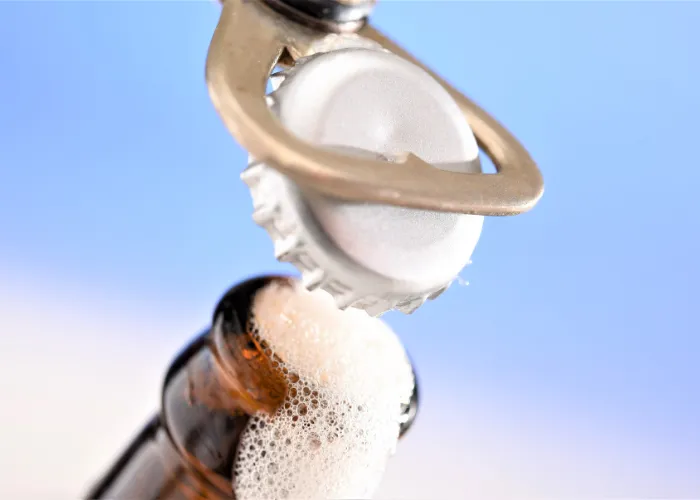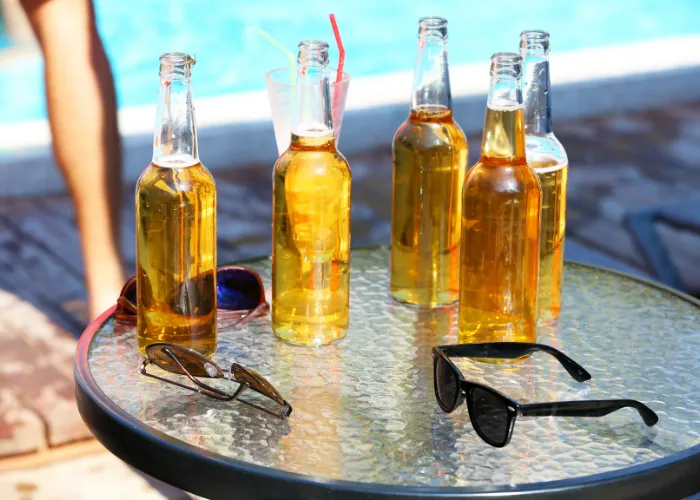Ever wondered, “How long can a beer sit out open?” Whether it’s the lone bottle from last night’s gathering or a casual drink left unfinished, this question haunts many.
This guide aims to demystify the journey of an open beer, blending science with practical insights to ensure your next sip is delightful and safe. Let’s delve into what happens to that open beer and how you can make the most of it.
What Happens to Beer Once It’s Opened?

When you open a beer, it starts a race against time and elements. Two main factors kick in, affecting its taste, aroma, and overall enjoyment:
- Oxidation: The interaction with oxygen begins the moment beer is exposed to air, leading to potential flavor degradation. Oxidation can make your beer taste stale or flat, a common concern for those savoring their brews.
- Carbonation Loss: Beer’s fizz isn’t just for show; it’s integral to its texture and taste. Once opened, the escape of carbonation over time diminishes this effervescence, affecting the beer’s overall character.
Understanding these changes is key to maximizing your beer experience, especially if you’re not planning to finish it immediately. Let’s explore how these elements play out and what you can do to keep your beer enjoyable for as long as possible.
Factors Affecting an Open Beer’s Shelf Life

Several external factors influence the shelf life of an open beer, each playing a significant role in determining how long your beer can maintain its quality and taste. Let’s explore these factors in more detail:
Temperature and Environment
Temperature plays a pivotal role in the beer aging process. Lighter beers, such as lagers and pilsners, are particularly vulnerable to higher temperatures, which can accelerate spoilage by promoting faster oxidation and loss of carbonation.
These beers are best kept in cooler environments to preserve their crisp and refreshing taste. Darker or higher-alcohol content beers, like stouts and porters, have a slightly higher resilience to temperature fluctuations due to their robust flavor profiles and the preservative effect of alcohol.
However, even these stronger beers benefit from consistent, cool storage to maintain their intended flavor characteristics over time.
Exposure to Light
Light, especially UV rays, can harm beer quality, known as “lightstrike.” Beers with higher hop content, such as IPAs, are more susceptible to this condition, leading to a skunky aroma and taste.
This is due to the light-sensitive compounds in hops that react adversely when exposed to light. Clear and green glass bottles offer little protection against this effect, making brown bottles, cans, and kegs more suitable for minimizing light exposure and preserving the beer’s quality.
Beer Type and Alcohol Content
The type of beer and its alcohol content significantly influence its shelf life post-opening. Beers with lower alcohol content and delicate flavor profiles, such as wheat beers and light ales, are more prone to spoilage and flavor degradation when left open.
The higher alcohol content in beers like barleywines and imperial stouts acts as a natural preservative, extending their shelf life even after opening. However, it’s important to note that while alcohol can help preserve beer, the nuanced flavors of these stronger brews can still change over time, making proper storage essential for all beer types.
By understanding how temperature, light, and the specific type of beer interact, you can take more effective steps to preserve the quality of your open beer, ensuring that every sip is as enjoyable as the first.
How Long Is It Safe to Drink an Open Beer?

The safety and enjoyment of an open beer can vary, but here are some key points to consider:
- General Timeframe: Open beers are best within 24 to 48 hours if kept cool and dark.
- High ABV Beers: Higher alcohol beers may last longer but will still degrade in flavor.
- Signs of Spoilage: Look out for off-smells, color changes, or a flat taste, indicating it’s past its prime.
- Health Risks: While not common, beers left out for extended periods could potentially harbor bacteria.
Rely on your senses to judge an open beer’s condition. When in doubt, it’s better to discard it. Next, we’ll dive into storage tips to maximize the shelf life of your open beer.
Storage Tips for Open Beer
Proper storage can significantly extend the life of an open beer. Here are some practical tips:
- Refrigerate Immediately: Keeping an open beer cold slows down oxidation and loss of carbonation.
- Seal Tightly: Use a beer stopper, plastic wrap, and rubber band to minimize air exposure.
Contrary to some myths, reheating or re-refrigerating open beer does not restore its freshness and can hasten spoilage. For optimal enjoyment, consume open beer as soon as possible and store it under the right conditions if you must wait. Next, we’ll explore creative ways to use beer that might not be fresh enough but is still too good to waste.
Creative Uses for Leftover Beer

If your open beer has lost its prime but isn’t spoiled, consider these inventive uses:
- Cooking: Beer can add depth to stews, marinades, and bread, infusing dishes with unique flavors. Check out these top beers for a robust marinade for your next steak night. Explore top beers for marinating steak
- Gardening: Some plants benefit from the yeast and sugar in beer, making it a good addition to compost or as a fertilizer in small amounts.
Repurposing leftover beer can be fun and sustainable, turning what might seem like waste into something worthwhile. Next, we’ll look at recognizing when beer has gone bad and should be avoided.
Safety and Spoilage Signs
The safety and quality of beer left out too long hinge on recognizing spoilage signs and understanding their health implications:
- Visual Signs: A noticeable haze or sediment formation, not typical for the beer style, often indicates spoilage. Beers meant to be clear should not become cloudy without reason.
- Olfactory Cues: A sour or acidic smell, reminiscent of vinegar, can signal bacterial contamination, which may pose health risks if consumed.
- Taste Changes: A marked shift in taste, such as an unwelcome sourness, excessive bitterness, or a flat, lifeless profile, suggests the beer has gone beyond its prime.
While consuming slightly stale beer is generally not harmful, beer that shows clear signs of spoilage, especially those indicating bacterial growth, should be avoided to prevent potential health issues. It’s always better to err on the side of caution when consuming any food or beverage that might be spoiled.
FAQs

Addressing common queries can help clarify doubts and enhance your beer experience. Here are some frequently asked questions:
Can I leave beer out overnight?
Yes, you can leave beer out overnight, but it’s best to consume it within 24-48 hours, ideally when stored in a cool, dark place, to maintain its quality.
Does beer go bad if it gets warm then cold again?
Temperature fluctuations can affect beer quality, but such changes won’t immediately spoil it. Consistent storage conditions are recommended to preserve its taste.
How can I tell if beer is too old to drink?
Check for off-odors, changes in color, or a flat taste as indicators. These signs suggest the beer may not provide the desired drinking experience and could be too old.
Is flat beer safe to drink?
Flat beer is generally safe to drink if there are no signs of spoilage, such as off-smells or unusual appearance. However, the taste experience may be diminished.
How does temperature affect the shelf life of different beer styles?
Temperature impacts beer styles variably. Light beers like lagers are more temperature-sensitive and can spoil faster in warm conditions, whereas darker, high-alcohol beers like stouts may be slightly more resilient but still require cool, stable environments to maintain quality.
Can exposure to light spoil beer faster, and are some types more susceptible?
Yes, light can accelerate spoilage, especially in hop-rich beers like IPAs, due to a reaction that creates a skunky flavor. Darker bottles and cans offer better protection against this light-induced spoilage.
How do higher alcohol content beers fare once opened compared to lower alcohol beers?
Beers with higher alcohol content generally have a longer open-shelf life due to alcohol’s preservative properties. In contrast, lower alcohol beers, being more delicate, are prone to quicker spoilage.
What’s the best way to store an open beer to extend its shelf life?
Refrigerating an open beer and sealing it tightly with a stopper or plastic wrap can help extend its shelf life by slowing down oxidation and carbonation loss, regardless of the beer type.
Are there specific signs of spoilage to look out for in different beer styles?
Common spoilage signs like off-smells, cloudiness, or off-flavors apply to all beer styles. However, the intensity and nature of these signs can vary, with lighter beers showing more noticeable changes sooner.
Is it safe to drink a flat beer, and does this differ by beer type?
While flat beer is generally safe to drink if there are no other spoilage signs, the enjoyment may be reduced, especially in beers where carbonation is key to the flavor profile, such as pilsners and IPAs.
For more detailed inquiries or specific situations, it’s always best to consult with beer experts or refer to comprehensive guides. Now, let’s conclude with a conclusion that combines all the key points we’ve discussed.
Conclusion

Navigating the open beer storage and consumption world doesn’t have to be daunting. By understanding the effects of oxidation, carbonation loss, and the importance of proper storage, you can significantly extend the enjoyment of your brews. Remember, the key takeaways are:
- Open beers are best enjoyed within 24-48 hours, especially when stored in cool, dark conditions.
- High ABV beers may last a bit longer, but all beers will eventually lose their optimal flavor and carbonation.
- Recognize the signs of spoilage through visual, olfactory, and taste tests to ensure your beer is still enjoyable and safe.
- Creative repurposing of leftover beer can be both fun and sustainable, adding unique flavors to dishes or aiding in gardening.
Beer is more than just a beverage; it’s an experience. By following these guidelines, you can enjoy your beer responsibly and within the best quality parameters. Cheers to making the most of every sip, even if it’s from an open beer sitting out a little longer than planned.
Additional Reading
For further reading and to enhance your understanding of beer storage, spoilage, and creative uses, consider exploring the following resources:
- A Beer’s Sugar Guide
- Effects of Freezing on Beer
- Chilling Beer on Ice
- Beer Capitals Around the World
- Engaging Beer Games
- Combining Beer and Milk
These resources provide a wealth of knowledge for beer enthusiasts looking to deepen their appreciation and understanding of beer in various contexts.


